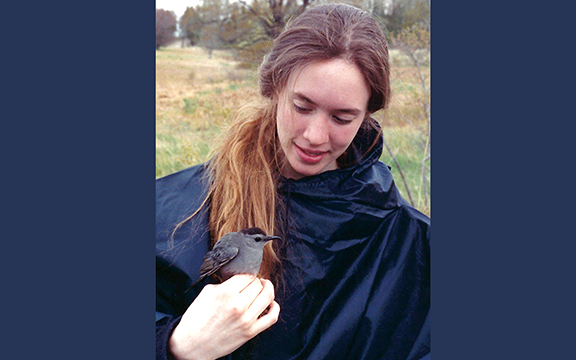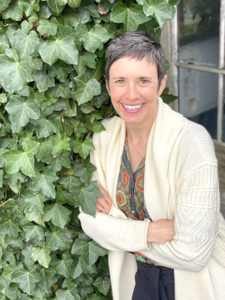
(Photo: Gita Brown with a catbird during an ecology class trip, Michigan, 1990.)
I awoke in the dark morning of early June to the lemony song of a catbird. My body lay heavy with sleep. But my mind began to prowl. As the catbird sang I tried to identify the bird calls he mimicked. My ears strained to classify the snippets he copied: the high whistle of an osprey and the tuk tuk of a robin. I could already feel anxiety carving my abdomen into a hollow bowl.
Later that morning I would tell my boss that I was leaving my career as a music therapist to teach Yoga. I was afraid to lose the title that had defined my identity.
I moved into a seated position for morning meditation. The catbird chirruped his looping song. He was a familiar visitor that spring; I had begun calling him George. I wiggled my toes into a fleece blanket and set my meditation timer.
I usually grind against morning meditation. There is no grace and little cheer. But twenty years of daily practice had taught me that I’d find the benefits later. It was like rinsing my mind clean. I needed a clear mind for the day ahead, lest my insecurity push me to another grasp at external approval. I had always used my career accolades as inoculation against self-doubt.
George marked his territory with an improvised riff that whistled, chirruped, and squeaked. I could picture him on top of the tangled wisteria; his black-capped head tilted up as his slender grey body curved towards the rising sun. I joined my voice with George’s and chanted “Om” three times. I learned my meditation practice from swamis—monks and nuns in the Integral Yoga tradition—at an ashram called Satchidananda Ashram–Yogaville in rural central Virginia. For more than a decade I had spent part of every year training and living at the ashram.
Together we’d rise early and welcome the day with a routine of chanting, breathing, and silence. The structure of the meditation was like a roadmap that kept me entertained as I learned how to focus. So much of what I feared that day lay tucked into the grooves and folds of my brain. My thoughts were tuned to identify career validation as a proxy for self-worth.
My learned parents, both PhD organic chemists had thrived in their careers—one a long-term professor and the other a pharmaceutical wizard. Each had internal and external validation for their passions: generous salaries, publications, patents, and advancement. They unfailingly supported my musical dreams while I searched for career accolades as a classical clarinetist and then music therapist. I had been caught in a restless search for validation that would somehow mirror their success. But collecting degrees and performances never settled the anxiety I carried deep in my belly. I had yet to realize that my identity lay beyond names and forms.
I chanted the opening slokas, simple chants that invite the mind to become a curious observer. My mind spent most of its time reacting and judging; the slokas were a reminder to be curious. The lilting phrases brought me back to my simple cross-legged position and the weight of the fleece across my lap. But my mind crept outward and began listening to George.
Tuk tuk tuk, he said as he imitated a robin’s alert call. Catbirds, like mockingbirds, are members of the mimid family. They fly along the Northeast corridor and gather sounds—other birds, frogs, car alarms—and string them together like a mixtape. I lost myself in his improv and waited to see if he’d repeat the robin’s alarm call. Instead the anxiety in my abdomen flared. Grudgingly I pulled myself back to the meditation structure. After the opening chants came the breathing practices. I tried to empty my agitation by lengthening my exhale. I could almost see the heat of anxiety leaving my body. I felt my shoulders relax. My belly began to cool. The fleece blanket felt warm.

(Photo: Lilacs blossoming.)
On my next inhale I smelled the powdery scent of lilacs. For weeks they had closed their tiny fists in protest against the chilly spring. The sweet smell brought me back to the summer after I graduated college with a degree in clarinet performance. At a lilac festival my then-boyfriend and I had walked and kissed among the blooms. Back then I had assumed my identity would play out as I had planned. My career as an orchestral clarinetist made me feel secure. I didn’t know that my intellectual grasping was a limited form of self-identification.
Back in my bedroom I pushed against the barrage of folded memories. I began to chant a mantra aloud. On days where my mind couldn’t focus the swamis had repeat me a mantra aloud, a short phrase to help concentration. I slowly chanted Om Shanti which translates in English as peace. But rather than pointing to an external construct of peace the vibration is said to be both the meaning and pure experience of peace. By chanting Om Shanti one can drop beyond the intellectualization of peace and move directly into peace itself.
I joined my voice with George and chanted quickly as if matching my racing thoughts. The phrases of the mantra stacked on top of each other as my ears finally turned inward. After several minutes my thoughts latched together with the mantra. I felt the vibration in my chest. I slowed my tempo. I allowed space between phrases. I released the final repetition like placing a peach blossom into a stream. The silence grew. In the way a tea cup holds space for tea the mantra had held space for silence.
I used to avoid silent meditation. It felt like an abyss; an emptiness over which I was fearfully suspended. From above surely I would see my insecurity and pitch headlong down into fear. I wasn’t usually comfortable enough with myself to let go of the thoughts that defined my worth. But somehow—after George and the fleece blanket and the lilacs and the mantra—I dropped into silence. My body settled. My breath came and went. I hung above my mind and looked at it with benevolent curiosity. The fear that had carved my belly scrolled across my consciousness. As I observed it—rather than react—the fear released its need to be acknowledged. The silence folded and tucked itself around the fear. I sat.
Eventually the timer poked through the silence with a tinny electric bleep. I chanted the closing slokas, chants for universal peace, and offered gratitude to my teachers. I rose. I folded the blanket. I made some coffee. Later that morning I walked up our long driveway as I headed to the meeting with my boss. My step was light. My mind clear. A catbird, I like to think it was George, shot out from the undergrowth and landed on top of a mulberry tree. He sang snippets of songs. I wondered which song was his. Was it the collective jumble that defined him. Or was he wedged among the scattered fragments; glimpsed only in moments of silence.
Maybe my intellectual need to classify my life was only a poor translation of reality. Clinging to my title and my need to identify George’s song fragments were a crude means to make sense of our ground source of be-ing. Perhaps the only reality that carries enduring meaning is the one that rests beyond intellectual grasping. As we meditated together that morning—George on the wisteria and me under my fleece—we had fleetingly let go of names and forms. For a moment we dropped into pure experience.
I had my meeting that day. My boss and clients celebrated our connection and they supported my evolution. I’m beginning to understand that my identity is a collection of selves on which I’ll continue to riff and improv. I’m learning to play and enjoy the song. I’ll keep meditating until I feel settled in the knowledge that my deepest identity, the simplicity of I am that I am, will always be there; waiting to be found in moments of wonder and silence.
About the Author:
 Gita Brown is a wellness activist, musician, and writer. She is a certified Advanced Integral Yoga® teacher and licensed Yoga for the Special Child® practitioner. Through her “Yoga with Gita courses” and podcast, “The Gita Brown Show,” her mission is to teach her students how to adapt the traditional practices of Yoga to bring more ease, wellness, and joy into everyday life. Gita started Yoga as a teenager, when her love of Yoga grew in tandem with her career as a classical clarinetist and music therapist. For three decades, she has taught Yoga, wellness, and music courses at colleges, schools of music, community schools, private studios, public schools, and hospitals. She is currently finishing final revisions to her memoir. The story is about how she repurposed her wedding vows into a yogic vow to live love as a way of life—a pilgrimage that endured even as her husband and childhood sweetheart battled end-stage alcoholism. She offers Yoga to students of all ages and abilities through online programs and in person at her home studio at Three Dog Farm in Kingston, Massachusetts. Learn more about her services by visiting: https://www.gitabrown.com
Gita Brown is a wellness activist, musician, and writer. She is a certified Advanced Integral Yoga® teacher and licensed Yoga for the Special Child® practitioner. Through her “Yoga with Gita courses” and podcast, “The Gita Brown Show,” her mission is to teach her students how to adapt the traditional practices of Yoga to bring more ease, wellness, and joy into everyday life. Gita started Yoga as a teenager, when her love of Yoga grew in tandem with her career as a classical clarinetist and music therapist. For three decades, she has taught Yoga, wellness, and music courses at colleges, schools of music, community schools, private studios, public schools, and hospitals. She is currently finishing final revisions to her memoir. The story is about how she repurposed her wedding vows into a yogic vow to live love as a way of life—a pilgrimage that endured even as her husband and childhood sweetheart battled end-stage alcoholism. She offers Yoga to students of all ages and abilities through online programs and in person at her home studio at Three Dog Farm in Kingston, Massachusetts. Learn more about her services by visiting: https://www.gitabrown.com

